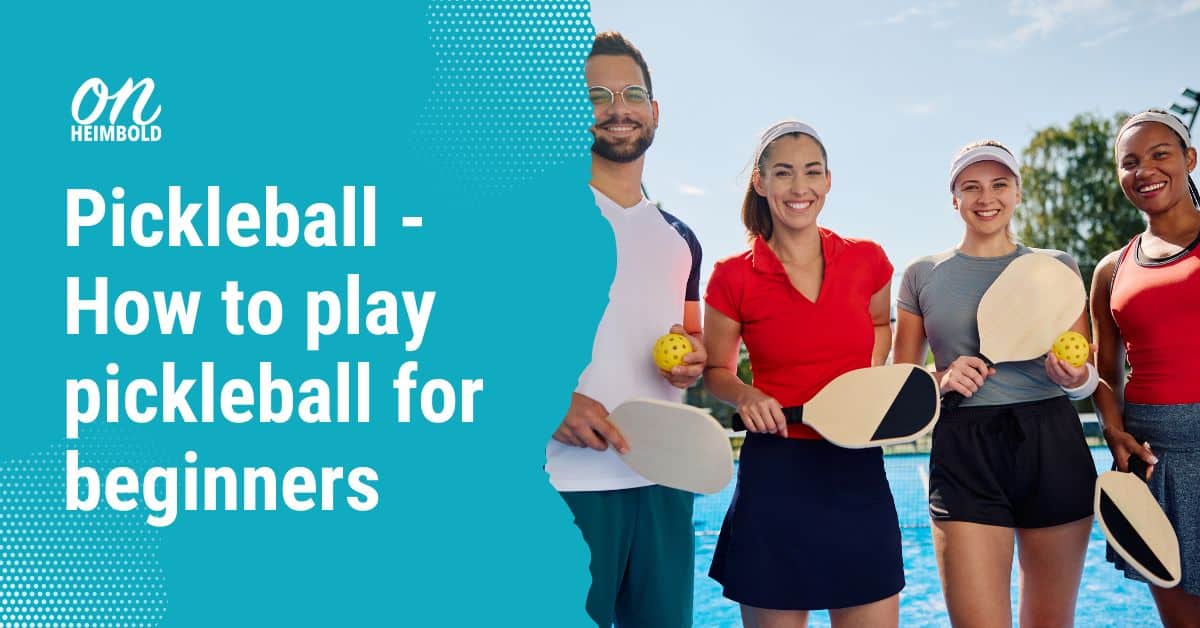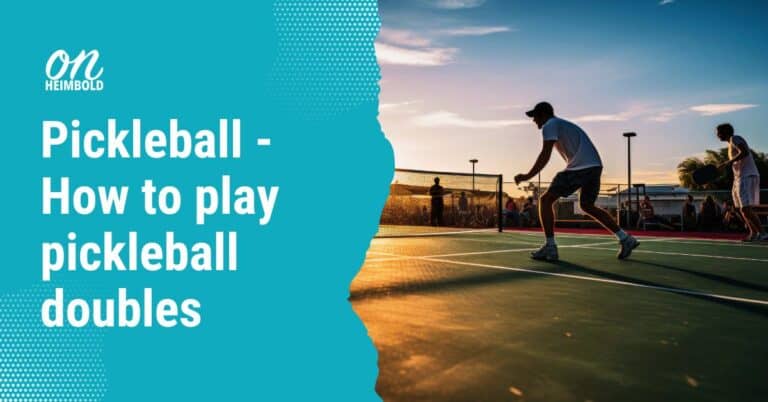How to Play Pickleball for Beginners: Basic Pickleball Rules
Welcome to the exciting world of pickleball! This guide is tailored for beginners, offering a step-by-step approach on how to play pickleball, ensuring you grasp the rules and start your pickleball journey effectively.
Pickleball, a rapidly growing sport in America with 4.8 million players in 2021, is a dynamic and captivating game blending elements of tennis, badminton, and ping pong. Played on a court similar in size to a badminton court, it features a net set at 36 inches on the sidelines and 34 inches in the center. A key area, known as the “kitchen,” outlines the non-volley zone.
Whether you’re interested in singles or doubles pickleball, this beginner’s guide will navigate you through the basics. In doubles, you partner up, whereas singles is a one-on-one challenge. The aim is to successfully hit the ball over the net while keeping it within bounds, scoring points by adhering to specific rules.
For those learning how to play pickleball for beginners, understanding the foundational aspects is vital. The game initiates with a serve that must bypass the non-volley zone or “kitchen.” Rallies can end with faults, such as the ball landing out of bounds or in the net. Scoring is exclusive to the serving team, with the game culminating when one team achieves 11 points and leads by at least two.
To embark on your pickleball adventure, the right gear is essential. You will need a pickleball paddle, access to a pickleball court, companions for the game, a pickleball, and attire that ensures comfort and mobility.
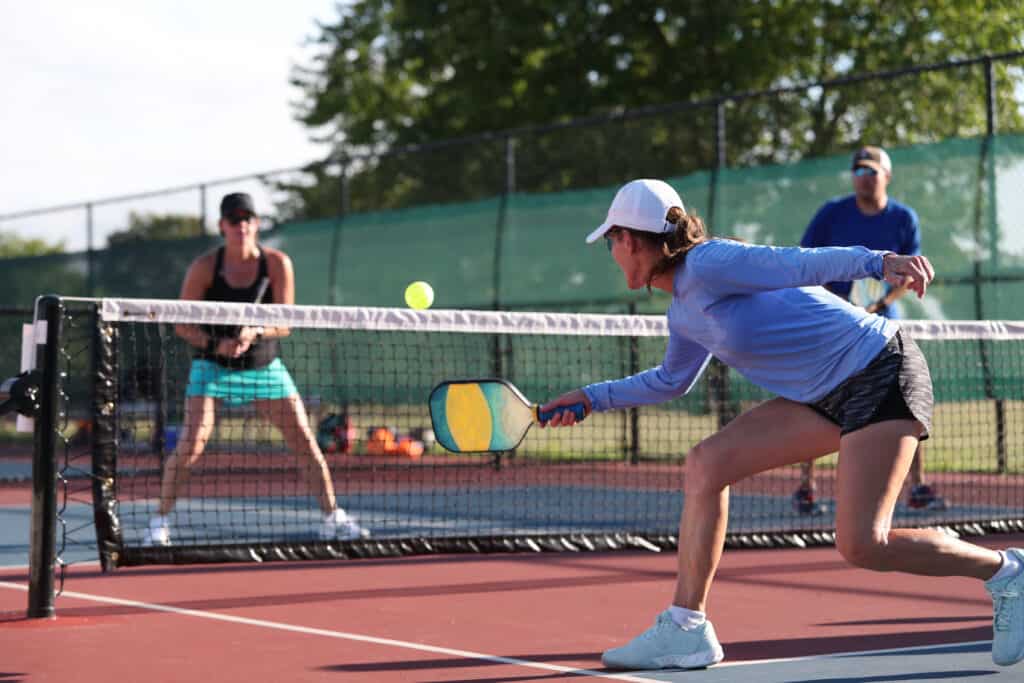
Create an image of the essential pickleball equipment, including paddles, balls, and a net. Show the equipment in action or in a setup for a game. Use vibrant colors to make the gear stand out and convey the excitement of playing pickleball. Consider adding motion or action lines to convey movement and energy as players hit the ball with their paddles.
Key Takeaways:
- Understand the basic rules of pickleball, including serving, faults, and scoring.
- Pickleball can be played as doubles or singles, providing different gameplay experiences.
- Equip yourself with the necessary equipment, such as a pickleball paddle and appropriate clothing.
- Get familiar with the court setup and boundaries, including the non-volley zone.
- Practice beginner-friendly strategies and tips to improve your pickleball skills.
Equipment and Game Setup
To start playing pickleball, you’ll need the right equipment and a well-prepared court. Here’s everything you need to know to get started:
Pickleball Equipment
Before stepping onto the pickleball court, make sure you have the following essential equipment:
- Pickleball paddle: Choose a paddle that suits your playing style and skill level. There are different materials and paddle shapes available, so take the time to find the one that feels comfortable to you.
- Pickleball: The game is played with a plastic ball, similar to a wiffle ball. Ensure you have a good supply of pickleballs on hand for uninterrupted play.
- Pickleball-specific clothing: Opt for lightweight, breathable clothing that allows for ease of movement. Consider wearing moisture-wicking materials to stay cool and comfortable during intense matches.
- Pickleball shoes: Proper footwear is crucial for agility and stability on the court. Look for shoes with supportive soles and good traction to prevent slips and falls.
Having the right equipment will not only enhance your performance but also ensure your safety and comfort while playing.
Pickleball Court Setup
Maintaining the correct pickleball court dimensions and boundaries is essential for fair and enjoyable gameplay. Here are some key elements of a standard pickleball court:
| Component | Measurement |
|---|---|
| Court dimensions | 20 feet wide x 44 feet long |
| Non-volley zone (kitchen) | 7-foot area on each side of the net |
| Service areas | Right and left sections closest to the net |
| Baselines | Back boundary lines on each side of the court |
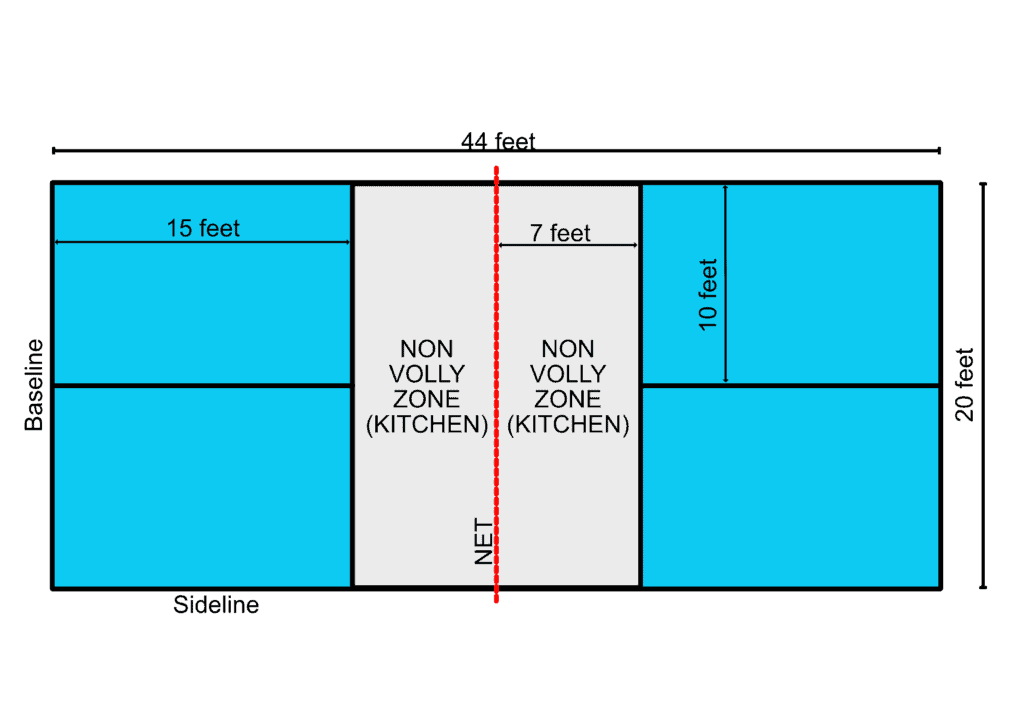
Ensure you set up the court properly and follow these dimensions and boundaries for a fair game. Additionally, mark the kitchen area clearly to avoid disputes during gameplay.
Now that you have your equipment and court ready, you’re all set to dive into the exciting world of pickleball. In the next section, we’ll delve into the basic rules of the game to get you started on the right track.
Learn how to play Pickleball for Beginners
Understanding the basic rules of pickleball is essential for beginners. In pickleball, there are two types of shots: volleys and groundstrokes.
Serving in pickleball involves hitting the ball diagonally to the opposite service area and clearing the kitchen. The kitchen is the non-volley zone near the net where players cannot hit volleys. By staying out of this area during volleys, players maintain a fair and balanced game.
The two-bounce rule is another important aspect of pickleball. The ball must bounce once on each side before volleys are allowed, promoting longer rallies and strategic play.
Just like in any sport, pickleball has fault rules. Faults occur when the serve doesn’t clear the kitchen, when a shot lands out of bounds, or when a shot goes into the net. These faults result in the loss of a point or the end of a rally.
Scoring in pickleball is unique. Only the serving team can score points, and they can score on their own serve or during a rally. The game ends when one team reaches 11 points, but they must win by two points. This ensures a competitive game and prevents quick, abrupt endings.
Rules to know – a guide for beginners at a glance:
- Types of shots: volleys and groundstrokes
- Serving: diagonal to the opposite service area, clearing the kitchen
- Two-bounce rule: the ball must bounce once on each side before volleys
- Faults: not clearing the kitchen, out of bounds shots, shots in the net
- Scoring: only the serving team can score, the game ends at 11 points with a win by two
| Shot Types | Pickleball Serve | Two-Bounce Rule | Faults | Pickleball Scoring |
|---|---|---|---|---|
| Volleys and groundstrokes | Diagonal serve | Bounce once on each side | Serve doesn’t clear the kitchen Shot out of bounds Shot in the net | Serving team scores points Game ends at 11 points with a win by two |
Understanding and following these basic rules will ensure an enjoyable and fair game of pickleball. Get ready to have fun on the pickleball court!
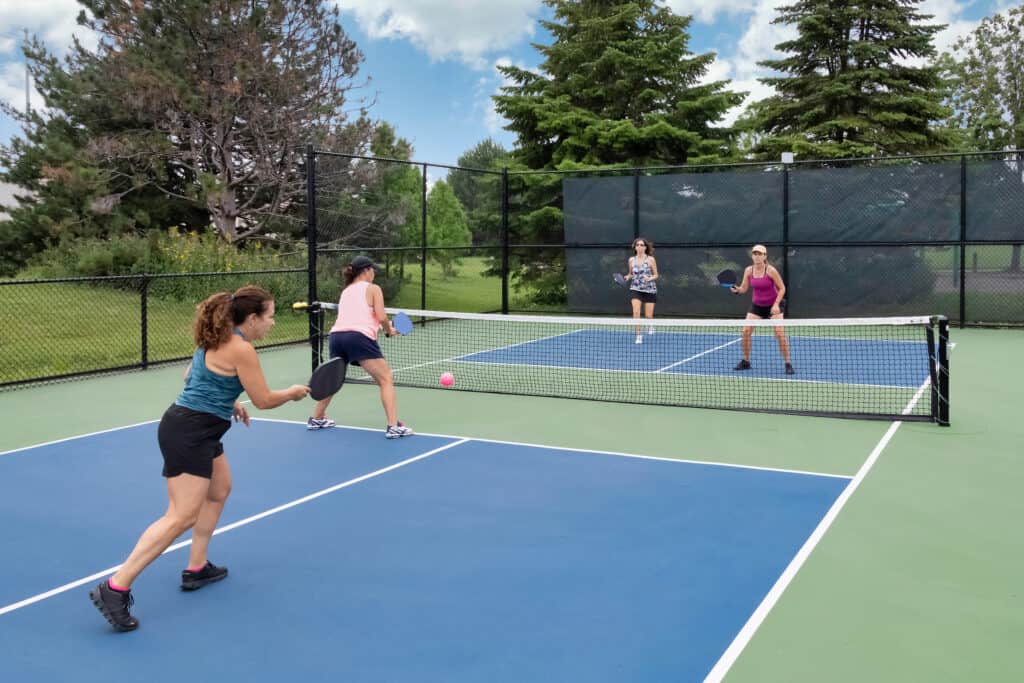
Show a simplified court layout with labeled boundaries and zones for serving and receiving, highlighting the no-volley zone. Include visual cues for the proper equipment and attire, such as paddles and non-marking shoes. Illustrate common faults, such as stepping into the no-volley zone or not serving properly. Show the correct scoring system and how to switch sides after each point.
Singles and Doubles Play
Pickleball is a versatile game that can be played as both doubles and singles. Whether you prefer the camaraderie of playing with a partner or the challenge of going solo, pickleball offers options for everyone.
In doubles play, there are two players on each team, making it a dynamic and strategic game. Both players on each team have the opportunity to serve, creating exciting exchanges and teamwork. The serving order in doubles is determined by the score, with each player announcing their score and their opponent’s score before serving.
In singles play, there is only one player on each side of the court. The first serve in singles is always on the right side, adding a unique element of consistency to the game. Scoring in singles is simplified compared to doubles, making it easier to keep track of points and stay engaged in the match.
Whether you choose to play doubles or singles, pickleball provides a fun and competitive experience for players of all skill levels. So gather your friends and hit the court for an exciting game of pickleball singles or doubles!
Benefits of Singles and Doubles Play
- Enhance teamwork and communication skills in doubles play.
- Enjoy the challenge and independence of singles play.
- Develop strategic thinking and decision-making abilities.
- Improve agility, endurance, and overall fitness.
- Experience the thrill of competitive play and friendly competition.
“Doubles play allows you to work together with your partner, strategize, and execute winning shots. Singles play gives you the freedom to control the entire court and rely solely on your skills.” – Mary Smith, professional pickleball player
Serving Techniques
Mastering the art of serving in pickleball is crucial for gaining an advantage over your opponents. Let’s explore some effective serving techniques that will elevate your game and leave your opponents scrambling to return your serves.
Underhand Serve
The underhand serve is the most commonly used serve in pickleball. To execute this serve, stand behind the baseline with your feet shoulder-width apart. Hold the pickleball paddle with a relaxed grip and extend your arm forward. Swing your arm in a pendulum motion, making contact with the ball below your waist. The underhand serve allows for better accuracy and control, making it a favorite amongst players of all skill levels.
Drop Serve
If you want to add variety to your serves, consider utilizing the drop serve. Start by holding the pickleball above your waist and let it drop to the ground. As the ball bounces up, meet it with your paddle and hit it just as it reaches the ideal height. The drop serve can catch your opponents off guard, making it difficult for them to return the ball effectively.
Serving Strategies
In addition to the different serve techniques, employing smart serving strategies can give you a significant advantage. Here are a few strategies to consider:
- Serve Deep: Aim to hit your serves deep into your opponent’s service area, forcing them to move back and giving yourself more time to set up your next shot.
- Keep the Serve Low: By keeping your serves low and close to the net, you reduce your opponents’ opportunities to attack and put pressure on them to execute difficult shots.
- Add Spin: Adding spin to your serves can make them more challenging to anticipate and return. Experiment with topspin, backspin, or sidespin to keep your opponents guessing.
By incorporating these serving strategies into your game, you’ll be able to keep your opponents on their toes and gain a competitive edge.
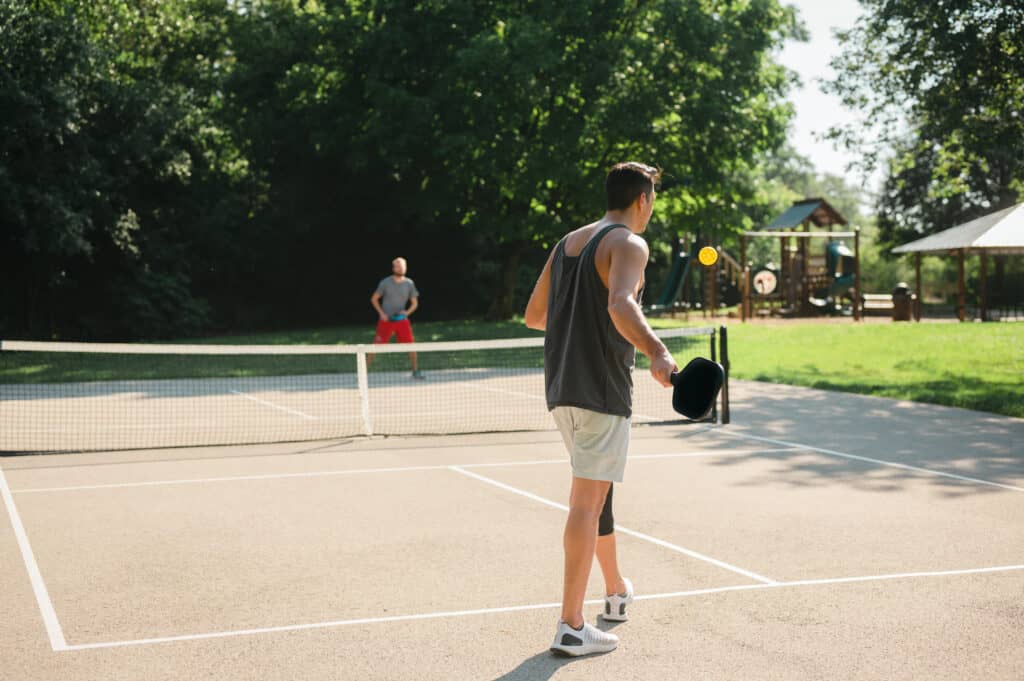
A close-up of a hand holding a pickleball paddle with a ball balanced on top, ready to be served. The hand should be in the foreground with the paddle and ball filling the majority of the frame. The background can be blurred out to focus on the serving technique.
Game Setup and Court Etiquette
Before you step onto the pickleball court, it’s crucial to familiarize yourself with the game setup and court boundaries. Understanding these aspects will ensure a smooth and enjoyable experience for both you and your fellow players.
Pickleball Court Setup
The pickleball court is typically 20 feet wide and 44 feet long. It’s important to note that the court dimensions may vary in some cases, but this is the standard size.
“Knowing the court boundaries is essential in pickleball to avoid any confusion during gameplay.”
The court is divided into different areas that serve specific purposes. The non-volley zone, also known as the kitchen, is a crucial part of the court setup.
Court Boundaries
The non-volley zone, or the kitchen, is a 7-foot area on each side of the net. Players are not allowed to hit a volley (a shot in the air without it bouncing) while standing inside the kitchen. This rule promotes fair play and strategic shot placement.
Additionally, the right and left service areas, as well as the baselines, are important parts of the court boundaries. Familiarize yourself with these boundaries to ensure accurate play and avoid unnecessary mistakes.
Non-Volley Zone Etiquette
Respecting the non-volley zone etiquette is crucial in pickleball. When inside the kitchen, you should avoid hitting volleys to maintain fair play and prevent accidents. This etiquette ensures that all players have an equal opportunity to engage in the game without facing unnecessary challenges.
Remember to stay outside the kitchen when returning a volley and move out of the zone once your shot has been played. Being mindful of the non-volley zone etiquette helps create a positive playing environment for everyone involved.
Court Etiquette
Playing pickleball, like any other sport, requires good sportsmanship and adherence to the rules. Respecting your opponents, communicating effectively, and maintaining a positive attitude contribute to a pleasant experience for all players involved.
Always follow the rules of the game and display fair play throughout your matches. Remember that the ultimate goal is to have fun and enjoy the sport, both individually and as part of a team.
Beginner Tips and Strategies
As a beginner in pickleball, there are several tips and strategies that can help you improve your skills and enjoy the game even more. By incorporating these techniques into your gameplay, you’ll be on your way to becoming a more proficient pickleball player.
1. Stretch Before Play
Before stepping onto the court, it’s important to warm up and stretch your muscles. Stretching can help prevent injuries and enhance your flexibility, allowing you to move more easily during the game.
2. Focus on the Ball
Keep your eyes on the pickleball at all times. By staying focused on the ball, you’ll be able to anticipate its trajectory and react quickly, giving you an advantage over your opponents.
3. Maintain Breathing
Remember to breathe deeply and regularly throughout the game. Proper breathing can help you stay calm, focused, and energized, enabling you to perform at your best.
4. Stay on the Balls of Your Feet
Be light on your feet by staying on the balls of your feet rather than flat-footed. This position allows you to move quickly and change direction effortlessly, improving your overall agility on the court.
5. Aim for Long Rallies
Instead of trying to win points quickly, aim for longer rallies with your opponents. Long rallies not only give you more opportunities to practice your shots but also increase your chances of wearing down your opponents and gaining an advantage.
6. Keep It Simple
When starting out, focus on mastering the basic shots and strategies. Keep your shots simple and consistent, rather than attempting complicated techniques. As you gain more experience and confidence, you can gradually add more advanced skills to your repertoire.
7. Learn from Mistakes
Don’t get discouraged by mistakes or missed shots. Instead, view them as learning opportunities. Analyze what went wrong, make adjustments, and use your mistakes as a springboard for improvement.
8. Have Fun
Remember that pickleball is a game and should be enjoyed. Embrace the camaraderie, friendly competition, and the joy of playing. When you approach the game with a positive and fun mindset, you’ll find that your skills naturally improve.
By incorporating these beginner tips and strategies into your pickleball game, you’ll be well on your way to becoming a more skilled player. Don’t forget to practice regularly and gain valuable experience on the court. Enjoy the journey and happy pickleball playing!
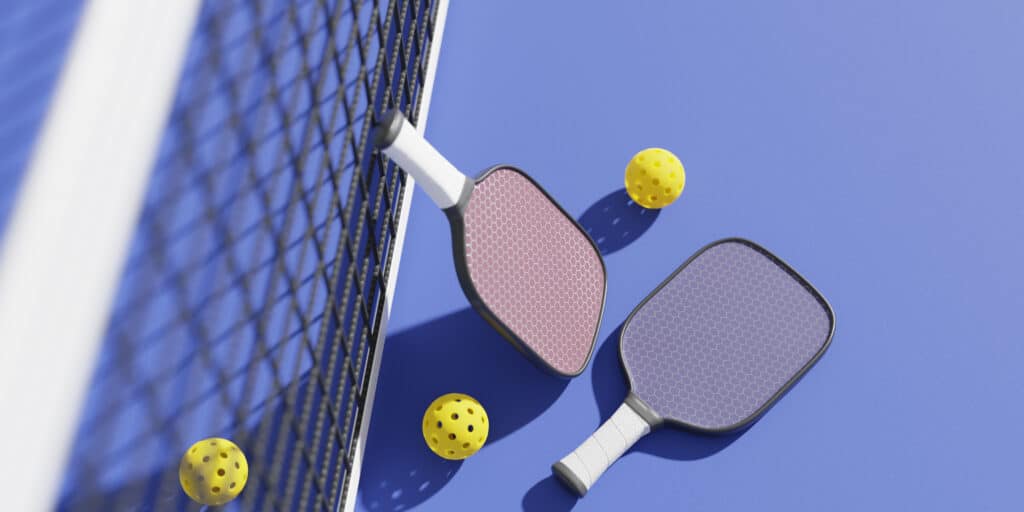
A cartoonish drawing of a beginner pickleball player holding a paddle with a confused expression on their face, while an experienced player gives them tips on how to position their feet and angle their paddle. The background should include a pickleball court with other players practicing in the distance.
Conclusion
Pickleball is a beginner-friendly sport that offers immense enjoyment and opportunities for growth. By learning the basic rules, understanding the necessary equipment, and practicing essential techniques, beginners can quickly become adept at pickleball. With the right mindset and dedication, anyone can excel in this fast-growing sport and experience the thrill of playing pickleball.
To begin your pickleball journey, make sure you have a pickleball paddle, find a suitable court, and surround yourself with enthusiastic players. Start by mastering the basic strokes and serving techniques. Remember to focus on your footwork, breathe properly, and maintain good sportsmanship.
As a beginner, don’t be afraid to make mistakes. Learn from them and keep practicing. Seek out tips and strategies to improve your skills. Engage in long rallies to enhance your endurance and work on your shot placement. Most importantly, have fun and enjoy the process of learning this exciting sport!
FAQ
How do you play pickleball for beginners?
To play pickleball as a beginner, start by learning the basic rules and techniques. Get the right equipment, find a pickleball court, and gather friends to play with. Serve the ball diagonally from the right side of the court, hit volleys and groundstrokes after the ball has bounced, and score points by winning rallies. Keep practicing and have fun!
What are the basic pickleball rules for beginners?
The basic rules of pickleball for beginners include hitting volleys and groundstrokes, serving diagonally, and clearing the non-volley zone (kitchen) on the first serve. Follow the two-bounce rule, avoid faults, and score points only when serving. Win the game by reaching 11 points with a two-point lead.
How to start playing pickleball?
To start playing pickleball, you’ll need the right equipment such as a pickleball paddle and a pickleball. Find a pickleball court, learn the basic rules, and gather friends or join a league to play with. Wear comfortable clothes and shoes designed for pickleball to enhance your performance.
What are some beginner pickleball tips?
As a beginner, focus on stretching before play, keeping your eye on the ball, breathing properly, and staying on the balls of your feet. Aim for longer rallies, keep your shots simple, learn from your mistakes, and most importantly, have fun while playing pickleball.
What are the pickleball basics?
The pickleball basics include hitting volleys and groundstrokes, serving diagonally, and following the rules of the game. Understand the court setup in pickleball, including the kitchen line (non-volley zone), and practice serving techniques. Get the right equipment and clothing to enhance your gameplay.
What are the beginner pickleball strategies?
As a beginner, focus on maintaining good sportsmanship, following the rules, and learning the basic techniques. Keep your shots simple, aim for longer rallies, and learn from more experienced players. Practice regularly to improve your skills and develop your own strategies as you gain experience.
How does scoring work in pickleball?
Points in pickleball are only scored by the serving team. The game continues until one team reaches 11 points, but a two-point lead is required to win. Faults can end a rally, and the non-serving team can only score points if they win the serve and become the serving team.
Can you play pickleball as singles?
Yes, pickleball can be played as singles. In singles play, there is only one player on each side, and the serving order is simplified compared to doubles. The first serve is always on the right side, and scoring is the same as in doubles.
What are the serving techniques in pickleball?
Serving in pickleball involves an underhand stroke. The serve typically takes place out of the air and must clear the net, land in the opponent’s service area, and stay in bounds. Different serving strategies include serving deep, keeping the serve low, and adding spin to your shots. The drop serve is an alternative to the traditional volley serve.
What is the non-volley zone in pickleball?
The non-volley zone, also known as the kitchen, is a 7 ft area on each side of the pickleball net. Players cannot volley the ball while standing inside the non-volley zone, but they can enter the zone after the ball bounces on either side. Special rules apply in the non-volley zone to prevent players from being too close to the net and dominating play.
What is the game setup and court etiquette in pickleball?
The pickleball court is 20′ x 44′ and has specific areas like the non-volley zone, service areas, and baselines. Players should be aware of court boundaries and follow proper etiquette when playing in the non-volley zone. Good sportsmanship and adhering to the rules are essential aspects of pickleball court etiquette.

